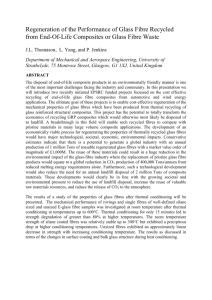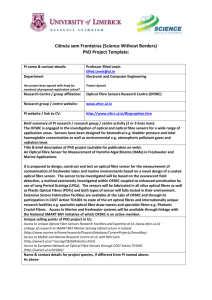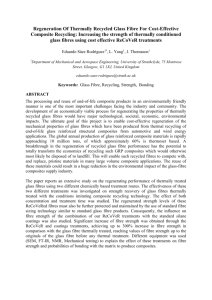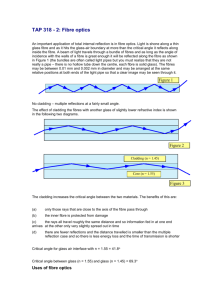Optic Fibres
advertisement
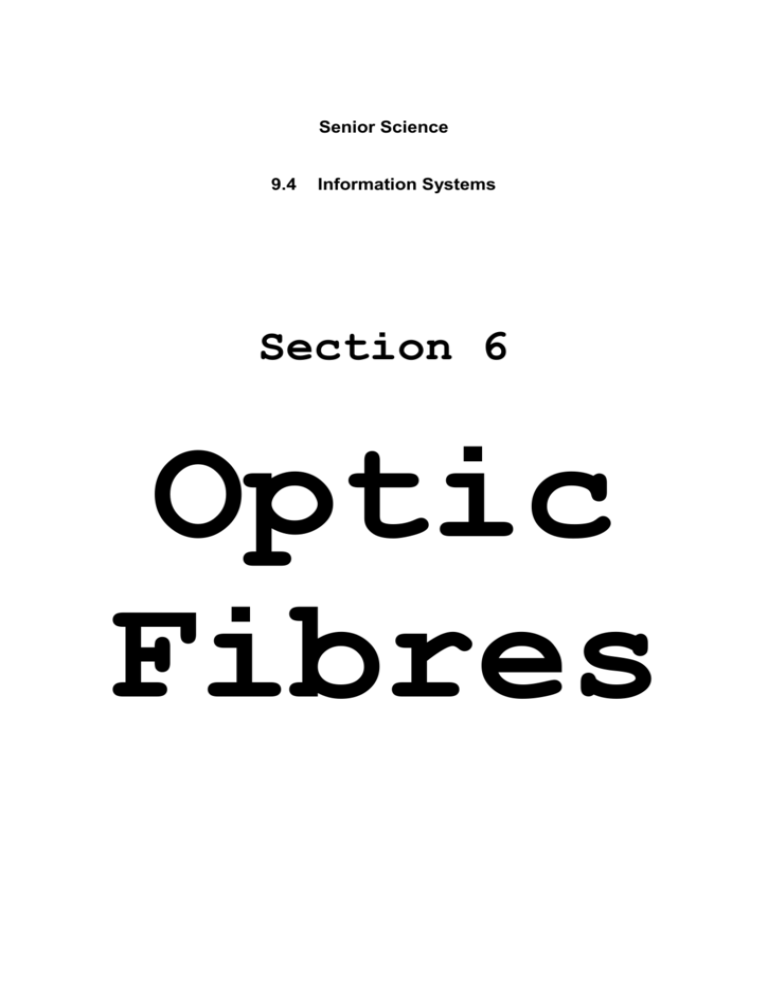
Senior Science 9.4 Information Systems Section 6 Optic Fibres 9.4 Section 6 ::: Optic Fibres Electrical energy can be converted to light energy for use in optical fibre communication systems 9.4.6.a Outline properties of optical fibres as communication carriers 9.4.6.b Outline the principle of total internal reflection and relate this to the advantages of fibre optics over more conventional carriers of information 9.4.6.c Outline the differences and relative merits in the use of fibre optic cables and metal cables to transmit and receive information 9.4.6.i Perform a first-hand investigation to demonstrate the transmission of light through an optical fibre 9.4.6.ii Process and analyse information from secondary sources to compare and contrast copper cables with fibre optic cables in relation to - carrying capacity - cost - rate of information transfer - security © P Wilkinson 2002-04 2 Introduction :: Using light to communicate All early light wave communication systems had two major problems 1. The transmission path needed an unobstructed line of sight between transmitters and receivers. This is because light cannot go around corners by itself. 2. The transmission path was affected by weather conditions. These problems were overcome by developing waveguides. The early designs were expensive and could not compete with electrons travelling through copper wire. The use of glass as a waveguide seemed to be a good idea. Light passes easily through glass. But, there are problems using glass as a waveguide. One problem is the quick loss of light within the fibre (attenuation of light). A quick activity: Turn a piece of glass on its end Can you see through it? What colour do you see? In fact, a few centimetres of ordinary glass is opaque. By looking at the end of a glass sheet this can be easily seen. The glass is an opaque green colour. The colour is due to the presence of impurities such as copper, manganese and other minerals. Several technological breakthroughs have resulted in a communications revolution using glass as the transmission medium. The development of the transistor and computer chips. The development of laser The development of optical fibres – made from very pure glass.. The development of light detectors Putting together a lightwave system http://www.bell-labs.com/technology/lightwave/system.html It is common to talk about using visible light in the optic fibres of the telephone system. However, most optic fibre communication does not use light. Rather, infra red wavelengths are actually used. Light refers to the portion of the electromagnetic spectrum that is visible to the eye – 770 to 330 nanometers (770 x 10-9 meters to 330 x 10-9 meters). Infra red radiation is used because it loses less energy and can travel greater distances through the optic fibre. Only certain sections of the infra red spectrum are used in optical fibres for communication – these are bands around 850nm, 1300nm, and 1550nm. Visible light in optic fibres has a large number of uses. A fibrescope is a particular example. A device in which a number of fibres are combined in order to transmit an image is called a fibrescope. A large number of fibres need to be combined in one bundle to provide a satisfactory image. In the average fiberscope there are 750 000 fibres, each being 0.001 centimetres in diameter. These instruments have a wide range of applications. For example, they are used to view internal organs such as the stomach. They also have found wide range of uses in industry. For example, it can be used for inspection in inaccessible areas to examine turbines and in parts of a nuclear reactor. © P Wilkinson 2002-04 3 Optical demonstrations A. Laser light Reflection Activity Question Response Shine a laser across the room onto a wall. Why do we see a red spot? The laser is reflected off the wall. Our eyes detect the light energy as it in the visible region of the electromagnetic spectrum. Activity Question Response Shine a laser across the room. Tap a blackboard duster above the beam. Why do we see the beam? The laser beam is reflected off the chalk particles suspended in the air. Activity Reflect the laser beam using a normal mirror. Measure the angle of incidence and the angle of reflection How do these angles compare I = R; The angle if incidence equals the angle of reflection. Question Response B. Refraction Activity Question Response Shine the laser through an empty beaker and note where the beam exits. Repeat while pouring water into the beaker. What happens? As the water fills the beaker, the light passes through a different medium. This causes the laser to bend more. Activity Question Response Shine the laser onto a solid block of ice What happens? The block of ice glows as the light is totally internally reflected due to the flaws in the ice structure. Activity Question Response Shine the laser onto the round side of a semicircular prism. What happens? As the angle of incidence increases past the critical angle the laser beam will no longer be transmitted but will be internally reflected. Activity Shine the laser horizontally into the side of a plastic bottle at a small hole on the opposite side of the bottle. Slowly fill the bottle with water. What happens? The laser light will be totally internally reflected within the water spout and will appear in the bottom of the beaker used to collect the overflow. Try this on an OHP! Question Response © P Wilkinson 2002-04 4 9.4.6.a Outline the properties of optical fibres as communication carriers What is an Optic Fibre? An optic fibre consists of two sections with a covering. The glass core, which runs through the center of the strand, and The glass cladding, that surrounds the core. The glass in the cladding is optically less dense than the core glass. As such the cladding glass has a lower refractive index. This causes the cladding to act as a mirror for light travelling in the core. As a result, the light (infra red) travels through the core by a series of continuous reflections. Diagram A Single Mode Optical Fibre Colour coating – 10 m thick Coating – 250 m diameter; (special acrylate) Cladding – 125 m diameter; silica glass Core – 10 m in diameter; silica glass Diagram: Size of an optical fiber compared to some common objects. © P Wilkinson 2002-04 5 The Properties of Optical Fibres as Communication Carriers The main job of an optical fibre is to guide light with a minimum loss of signal. Optical fibres have a number of properties that allow them to act as communication carriers. An optical fibre is made from very pure, almost mineral free glass. This purity means that light can travel through an optic fibre for hundreds of kilometres. An optic fibre cable is flexible and can be easily bent. This flexibility makes the fibre very useful. It means that the cable can be laid so that it bends around obstacles without the need for special relay (reflection) devices. The structure of an optic fibre results in light rays undergoing total internal reflection. This is an important property of the fibre as it means light is transmitted with very little loss of energy over long distances. Optical fibres are capable of transmitting light at about 2/3 the speed of light in a vacuum. This means that communication using optic fibre is very fast. When an optical fibre transmits light there must be some loss of signal strength. Attenuation is the loss of signal strength. The amount of light coming out at the end of the fibre is less than the amount of light originally transmitted. Certain properties of the fibre cause a loss of signal strength. (ie attenuation). Impurities in the glass absorb some of the light. The impurities are mostly heavy metals such as iron, copper, vanadium, cobalt, nickel, manganese and Chromium. OH- ions that come from water are also impurities that absorb signal strength. Certain wavelengths must be avoided 1.37, 1.23, 0.95m because of absorption by the OH- ions. Changes in density of the glass can cause the light to scatter. Light is lost at bends. At a bend, the angle at which the light hits the core/cladding interface results in transmission, not reflection. Light entering the cladding glass is lost. The Total Attenuation graph below shows the wavelength bands that are transmitted with the greatest efficiency (ie 850nm, 1300nm, and 1550nm). © P Wilkinson 2002-04 6 There are two basic kinds of optical fibres. Single-mode fibres Multi-mode fibres Not all rays entering a fibre will be guided through the fibre. Only some directions are allowed. These allowed directions are called modes. A multimode fibre supports more than one propagating mode. The signal loss (attenuation) in a single mode fibre is lower than that in a multi mode fibre. A single mode fibre ----------------------------------------------------------------------------------------------------------------------------------------------------------------- Cladding Core Cladding A multi-mode fibre Cladding Core Cladding Single-mode fibres are used for long distance transmissions. They have extremely small cores, and they accept light only along the axis of the fibres. As a result, single–mode fibres require the use of laser light. They also need to be precisely connected to the laser, to the other fibres and to the detector. Multi-mode fibres have cores larger than those of single mode fibres. They accept light from a variety of angles. Multi-mode fibres can use more types of light sources and cheaper connectors than single-mode fibres, but they cannot be used over long distances. Several optical fibres are usually packed together to make a cable. Diagram Fibre Optic Cable © P Wilkinson 2002-04 7 Notes Questions 1. Why can’t ordinary glass be used to make optical fibre? 2. What is special about the glass used to make optical fibres? 3. What is the source of light that passes through optic fibres? 4. For telephone communication, a. What part of the electromagnetic spectrum is used in optic fibres? b. What is the advantage of using this part of the electromagnetic spectrum? 5. Outline one situation in which visible light is used in optical fibres. 6. Name the important two sections of an optic fibre. 7. How does the infra red radiation travel through the optical fibre core? 8. An optic fibre core has a diameter of 10m – how many millimetres is this? 9. Which has the bigger diameter – an optic fibre or a human hair? 10. How far can infra-red travel through an optical fibre? 11. Why is it important that optical fibres are very flexible? 12. How fast does an infra red signal travel inside an optic fibre (answer in ms-1) 13. What is attenuation? 14. Name three impurities in the glass used for optical fibres? 15. Explain why it is important to remove impurities from the glass used for optical fibres. 16. What wavelength bands are used to transmit telephone signals in optical fibres? 17. What is an optical fibre cable? Notes Questions (for next page) 18. Complete Light travels (faster/slower) through air than through glass. 19. Draw a diagram showing a ray of light that is transmitted at a glass/air boundary. 20. Describe what is meant by total internal reflection (Draw a diagram). 21. Outline what is meant by the term “wave guide”. © P Wilkinson 2002-04 8 9.4.6.b Outline the principle of total internal reflection and relate this to the advantages of fibre optics over more conventional carriers of information How does fibre optics work? Light travels faster through air, than it does through glass. This is because glass is more optically dense than air. Light travels at different speeds through different types of glass or plastic. The optical density is not the same in different types of glass and plastic. When a ray of light reaches a boundary it can be both reflected and transmitted. The reflected ray is reflected such that the incident angle = the reflected angle. The transmitted ray is refracted (ie bent because of the change in speed in the different mediums) Diagram – reflection, transmission Diagram – Total internal reflection Sometimes, the ray of light undergoes total internal reflection. No transmission of the ray of light occurs (ie there is no loss of light from the glass). This only happens when the light is travelling from an optically dense medium to an optically less dense medium. Also it only happens when the ray hits the boundary at a sharp angle. It is total internal reflection that allows an optical fibre to act as a wave guide for light. Diagram A fibre optic wave guide showing total internal reflection Cladding Core Cladding In physics, angles are measured from the normal. The normal is a line drawn at right angles to the boundary surface. Therefore, total internal reflection occurs when a light ray hits the boundary at an angle greater than the critical angle. © P Wilkinson 2002-04 9 9.4.6.c Outline the differences and relative merits in the use of fibre optic cables and metal cables to transmit and receive information Optical Fibres versus Metal Cables? There already exists a large network of metal cables to transmit telephone messages. It is very expensive to replace this existing network of cables, particularly in remote areas. For this reason telecommunication companies are using both the “old” metal cables as well as gradually introducing new optic fibre technology. In remote areas use of satellite and microwave technology is cheaper than developing a cable link. Optical fibres have many advantages over conventional electrical circuits. Fibre optics technology is new but because of its high efficiency, optical fibre cables are steadily replacing the traditional metal lines. Currently all undersea cables are made of optical fibres. Greater information carrying capacity The wide bandwidth of optical fibre allows transmissions of very large amounts of data in very short times. With new technology it is possible to transmit 240 000 telephone conversations on a pair of optical fibres. Lucent technologies has recently developed a new fibre that is capable of carrying the current per-second traffic of the entire worldwide Internet traffic on a single strand of optical fibre. This is the same as transmitting over 90 000 volumes of an encyclopedia in one second. By comparison the best electrical or microwave links can carry around 100 000 telephone conversations. Lower energy loss With the very low energy loss of the latest optical fibres, spans of over 100km are possible. Generally, optical fibre signals need less amplification than signals sent down copper wire. Transmission of microwaves requires relay towers every 40 km. This is because microwaves need line of sight relays. Copper cables, like optical fibres, can be laid virtually anywhere. The signals in copper wires loose energy relatively quickly. Therefore, they require more regular boosting and larger energy input, than light signals. Not subject to electrical or electromagnetic interference Because glass is an insulator, there are no problems from contacts with electrical circuits or other fibres. For the same reason, there are also no problems such as cross talk and surge currents due to lightning strikes. Consequently, there is no need for cable transposition schemes or high voltage protection equipment. Optic fibre wave guides are not affected by inclement weather Lightning strikes can severely effect metal telephone lines – high voltage protection equipment needs to be installed. © P Wilkinson 2002-04 10 Weight An optical fibre is thinner than a human hair and takes less room than an ordinary metal cable. Individual fibres are not particularly strong, but a cable can be very strong by having a Kevlar ‘outer jacket’ and a central strength member. Metal cables are quite strong. However, to transmit the same volume of data as an optical fibre, the equivalent metal cable would be much larger and therefore very heavy. Security It is difficult to cut into an optic fibre to listen to another persons telephone conversation. The digital nature of the signal and a number of other factors means very sophisticated and expensive electronic equipment would be needed. For this reason, security of telephone conversations and other transmissions of data is quite high. Phone tapping of metal cables is relatively easy and cheap. Since mobile phones broadcast their signal to nearby transmission towers, other people can intercept the signal. Concerns about privacy are therefore an issue with these telephones. Jointing optical fibres Signal losses occur at joints in optical fibres. It needs to be a precise procedure. The usual method is called fusion splicing. The two fibres are fused or welded together. The ends of each fibre need to be squared, cleaned and then butted together under a microscope. An electric arc is used to weld the ends together. Most fusion splicing sets now have automatic control of both arcing time and fibre alignment. Joining electrical cables is relatively easy and can be performed with very little specialised equipment. Signal boosting In fibre optic communication, the signal can become distorted. The distortions need to be corrected. Signal compensation and regeneration overcome this problem. Signal compensation is a cheap process needing little energy input and relatively simple technology. Regeneration is much more expensive and needs complicated, electronic technology. Regeneration also results in a energy input. In fibre optic communication the signals are digital – ie small, separate pulses of light. Light travels through the core at different angles. This means that different parts of the same signal (pulses) will travel different distances and will arrive at different times. Original pulse Dispersed pulse Compensator Compensated pulse As well, the individual pulses also spread out over the long distances travelled. The result is the receiver can no longer distinguish where one pulse begins and another ends. For electric signals, compensation and regeneration is not needed. Regeneration of signals does occur for microwave links. Cost . © P Wilkinson 2002-04 11 Notes Questions (for next page) 22. Why do companies like Telstra still use metal cables to carry telephone signals? 23. Give one reason why companies like Telstra might use microwave links rather than laying a cable system? 24. Name two advantages of fibre optic cables over metal wire cables. 25. How many telephone conversations can be transmitted on the “current best” optic fibre technology? 26. Compare the energy losses in optic fibres compared to metal wires. 27. Why do metal telephone cables need high voltage protection? 28. Name the two features of an optic fibre cable that makes it very strong? 29. Why is privacy an issue for mobile phones and telephones using metal cables? 30. Which cable is easier to join – optic fibre or copper wires? 9.4.6.ii Process and analyse information from secondary sources to compare and contrast copper cables with fibre optic cables in relation to - carrying capacity - cost - rate of information transfer - security © P Wilkinson 2002-04 12 9.4.6.i Perform a first-hand investigation to demonstrate the transmission of light through an optical fibre ACTIVITY Aim Total Internal Reflection To demonstrate total internal reflection Equipment Light ray box Wires Rectangular, glass prism Mirror Triangular, glass prism Power supply (transformer), Method 1. Set up the equipment as shown in the diagram below: Ray Box Triangular prism Power Supply In this investigation we are interested in the glass-to-air interface. That is when light is travelling from inside the glass to the air. 2. Shine a single ray of light onto the side of a triangular prism (as shown on the diagram above) at an angle of about 450. 3. Trace the outline of the prism and then draw the light ray before it enters the prism while it is inside the prism and as it leaves the prism 4. Label on the diagram where reflection and/or refraction occur. 5. Change the angle to obtain the situation shown in the diagram opposite. This should show total internal reflection. No light should leave the prism where total internal reflection occurs. 6. Trace the prism and rays and label the resulting diagram. © P Wilkinson 2002-04 13 7. Shine a single ray of light into the end of a rectangular prism as shown in the three diagrams below. Fig. 1: Refraction Fig 2: Critical angle Fig 3: Total Internal Reflection 8. Trace the outline of the prism and then complete each diagram by drawing the light ray before it enters the prism while it is inside the prism and where the ray then goes when it reaches the glass-to-air interface. 9. Label on the diagram where reflection and refraction occur. 10. Describe what happens to the ray in each diagram. Results 1. Draw diagrams to summarise what happens when a ray of light travels towards the glass-to-air interface. 2. Write a description under each diagram. Conclusion Copy and complete the paragraph using the words from the list below. less dense, cannot, “greater than”, more dense, reflected, transmitted, can, no reflection When a wave reaches a boundary it can be ____ and ____. Light reaching an air/glass boundary ____ undergo total internal reflection. Light reaching a glass/air boundary ____ undergo total internal reflection. This happens if the incident angle is ____ the critical angle. It will only happen when the light is passing from an optically ____ medium (glass) to an optically ____ medium (air). When total internal reflection occurs there is ____ of light. © P Wilkinson 2002-04 14 ACTIVITY Aim Transmission through an optical fibre To demonstrate the transmission of light through an optical fibre Equipment Laser, Optic fibre Method 1. Shine laser light onto the end of an optic fibre © P Wilkinson 2002-04 15






